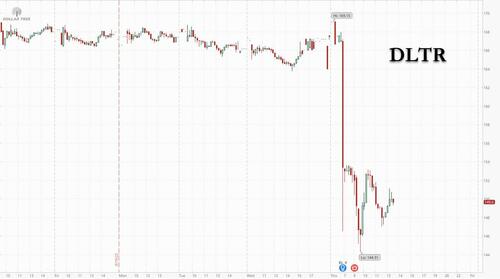From Dollar Twenty-Five To Dollar-Fiddy Tree? Discount Retailers Tumble As Recession Hits Consumer Spending
While the Biden administration is busy pretending there is no recession, both the lower and middle classes are seeing their spending shrink at an alarming, and yes recessionary, pace (according to “best-looking department store” around, Nordstrom, which just reported catastrophic earnings, the upper class may about to join them too). And after some dire results from Walmart, Target and so on, today it was the dollar stores’ turn to crash and burn, because as Bloomberg notes, “lower-income shoppers are increasingly pressured. This strain is even hitting dollar stores, which cater to less-affluent segments of the economy.”
To wit, Dollar Tree – which one year ago succumbed to the inflationary wave and was forced to hike its prices from $1.00 to $1.25 – tumbled after unexpectedly cutting its full-year profit outlook. The company said a “heightened focus on needs-based consumable products” was pressuring gross margins, with a shift from higher-margin discretionary merchandise to lower-margin consumable goods. It also mentioned inflationary cost pressures and its continued spending on labor and wages. As a reminder, Walmart cut its profit outlook as US shoppers concentrate on buying less-profitable groceries.
Here are some sellside comments on the company’s report:
Guggenheim, John Heinbockel
“We believed FDO’s initial investments would be modest, with more in 2023 than 2022, and in labor not price,” he writes, referring to Family Dollar
“While such investments may be necessary, we have (1) never found a solid intermediate-term ROI on significant price cuts, especially in an inflationary environment,” and the analyst generally hasn’t seen price leaders materially impacted by these investments
Notes that Dollar Tree’s guidance reset is also weighing on Dollar General shares, which are down about 1%
Wells Fargo, Edward Kelly
“No one really expected a cut to guidance given there seemed to be room in the core gross margin after the Q1 performance”
Says the deceleration in Dollar Tree segment comparable sales was expected, but it raises questions around whether it’s related to a weakening low-income consumer, a change in consumer demand with the $1.25 price point, or both
“We certainly understand the need to invest, and it’s a big part of the reason we have had concerns around the high 2023 consensus estimate/buy-side bar, but we have to be realistic and assume there is probably more to come”
Telsey Advisory Group, Joseph Feldman
“We are disappointed by the magnitude of price investments at Family Dollar, but we understand the proactive decision to improve its competitiveness that would help the brand win customers for the long-term”
Truist Securities, Scot Ciccarelli
“The selloff in the stock is nearsighted, as the DLTR story is all about the company’s longer-term earnings power given the new BOD and management team, especially given the material underperformance of Family Dollar relative to Dollar General,” he writes, referring to the board of directors
Dollar General shares also plunged, while off-price retailer Burlington Stores slid after cutting its outlook, citing a higher cost of living and inventory, with economic pressure on lower-to-moderate income shoppers likely to continue well into the second half.
Meanwhile, the only pillar propping up the US economy – now that both the lower and middle classes are retretnching – affluent consumers, have largely held up. Williams-Sonoma had a big beat and Coty said the premium side of mass brands and the prestige business were doing “fantastically well.” Still, as Bloomberg’s heather Burke notes, the cost-of-living crisis weighing on lower-income shoppers will make uncomfortable reading for the Fed.
Tyler Durden
Thu, 08/25/2022 – 16:40

